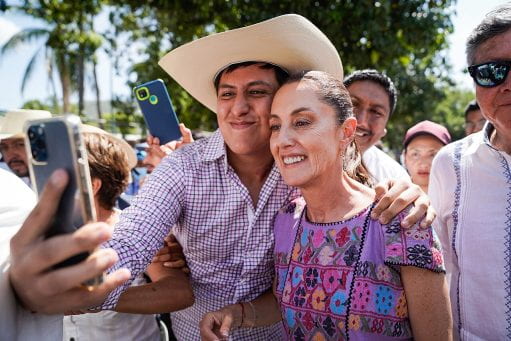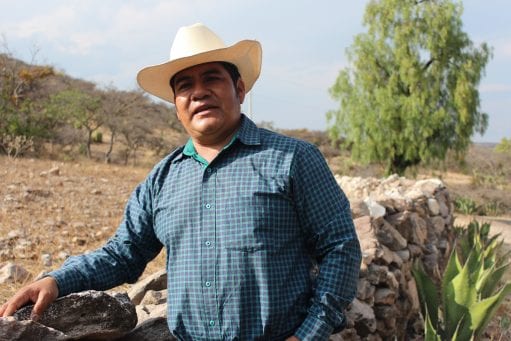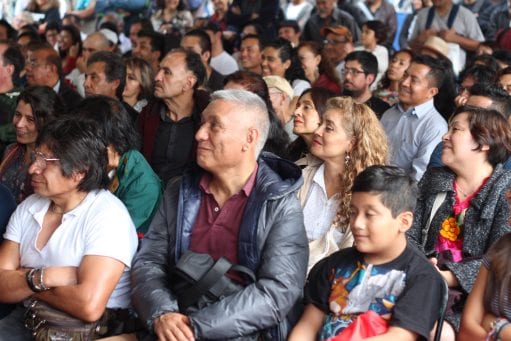Claudia Sheinbaum and the future of Mexico’s Fourth Transformation
By Sarah Flynn, on 5 February 2024
A blog written by Étienne von Bertrab, Lecturer (Teaching) at The Development Planning Unit.

Claudia Sheinbaum greeted by supporters at an informative assembly in Acapulco. Source: Wikimedia Commons
The original version of this text was presented at the seminar “Mexico’s 2024 elections and continuation of the Transformation” during the Latin America Conference 2024 on January 27th in Hamilton House, London. DPU’s Étienne von Bertrab was joined in the panel by William Booth (UCL Institute of the Americas) and by David Raby and María Pérez Ramos from Mexico Solidarity Forum.
On June 2nd Mexico will elect its first female president in 200 years as independent nation. It won’t be Xóchitl Gálvez, candidate of the opposition considered instrument of the country’s oligarchy, but Claudia Sheinbaum, an environmental scientist and social leader who has accompanied the political movement of Andrés Manuel López Obrador (AMLO) for over two decades. She is one of the founders of the Morena party and has admirably governed Mexico City this sexenio (six-year term) until stepping down last June to pursue the presidency.
Apart from this being a momentous event for Mexican society, the coming elections will be highly significant for the life of Morena after AMLO, as Claudia (for short) will be accompanied by five female gubernatorial candidates including leftist Clara Brugada who aspires to build on Claudia’s legacy in Mexico City. Indeed, as journalist Kurt Hackbarth puts it in his latest piece in Jacobin, “the next chapter in Morena’s history is set to be shaped by leftist women”.
The certainty I start with is founded both on AMLO’s remarkably high approval rates (unprecedented at this point in a presidential term) and on the numerous opinion polls that consistently give Sheinbaum a significant lead (20 to 30%) ahead of the opposition’s strongest candidate (Gálvez). But who is Claudia Sheinbaum and what could be expected from a second moment of Mexico’s Fourth Transformation?
There isn’t much space to elaborate on Claudia’s fascinating background and significant public life, but I would like to highlight some things from her trajectory and ways of thinking and doing.[1]
As a young student in the National University, UNAM, Claudia became an activist, first in movements of solidarity with workers and peasants and then as part of the wider student mobilisations of the 1970s and 1980s. She took part in the Comité de Lucha of her university campus and became prominent in the Consejo Estudiantil Universitario (CEU), a movement in defence of public education, at a time when neoliberalism started creeping up in Mexico’s education system.
Claudia got her first degree in Physics and did a masters in Energy Engineering. She was the first woman to enter the doctorate in energy engineering at UNAM and to obtain, in this institution, a PhD in the field. As a young mother she moved with her family to Berkeley, California, to undertake her doctoral research, but even there continued her political activism. Together with other activists she bravely gave President Carlos Salinas de Gortari a hard time in a triumphalist visit to sell the North American Free Trade Agreement (NAFTA). She worked hard as student while nurturing her political awareness and social commitment towards marginalised communities in her work on energy.
As a climate scientist, Claudia was a contributing author to the IPCC’s Fourth Report. For this work the panel received the Nobel Peace Prize (2007). She is a respected scholar in the energy and climate fields, and academia is a part of her life that she never fully abandons (although her life might become even a bit busier for a while).
Due to her solid trajectory on environmental matters and their clear political affinity Claudia was invited by AMLO to be the environment minister for his government of the capital city, then called Distrito Federal, from 2000 to 2005. As minister, Claudia was entrusted with key projects and led significant initiatives.
She supported the struggle against the desafuero of López Obrador[2] and was fundamental in the documentation of the electoral fraud that stripped AMLO from the presidency in 2006 (his first attempt). We need to remember that, since then, Mexico’s government and the business elites worked closely in well-funded smear campaigns to portray him as “un peligro para México” (a danger for Mexico). After the 2006 fraud Claudia returned to her academic activities at UNAM, but never abandoned her political action alongside AMLO.
Claudia was key in the defence of energy sovereignty —a central component of the proyecto obradorista de nación that took AMLO to the presidency in 2018— and was a great mobiliser of women in defence of such sovereignty.
Once AMLO broke with the then leftist party PRD as it allied with the conservative alliance (PRI-PAN) when Enrique Peña Nieto took power, Morena was founded, first as a civic organisation, and later —after discussions in assemblies— as a political party. Claudia Sheinbaum was part of Morena’s foundational process. The rest is history. Morena competed electorally for the first time in 2015 and only 9 years later governs, together with its allied parties, 23 of the 32 states that form the Mexican federation. It could win a few more states in the coming elections.
As mayor of Mexico City, Claudia Sheinbaum’s government expanded fundamental rights to public education, health, housing, culture, dignified employment at a fair wage, sustainable mobility, and a healthy environment. It also drove significant innovation. For example the integration of a solar power plant (now the world’s largest in an urban area) in the city’s food market, and public and free Internet connectivity throughout the city. The accomplishments of her administration are impressive and long is the list of international recognitions and prices. Mirroring what occurs at the national level, public investment in infrastructure and social protection are unparalleled, achieved through republican austerity (not the neoliberal version) and good governance, including combating corruption, without incurring in additional debt. A recurrent argument of the opposition is that Claudia Sheinbaum is candidate because of being AMLO’s favourite (or its “handpicked successor” as it is often framed in the media).[3] This (also misogynist) trope neglects her outstanding leadership and the extraordinary results of her government, putting, for the benefit of all, the poor first.
Claudia Sheinbaum’s programme is under construction. An anachronic electoral law forbids candidates to spell out specific proposals until campaigns officially start in March. However, political documents and ongoing processes are useful indications:
- Proyecto de Nación 2024-2030, consulted and written by a special commission of Morena (before the candidacy was determined). It addresses 19 themes considered major challenges of the Fourth Transformation. More than 15 thousand people participated in this process.
- An initial diagnostic produced by Claudia’s closest team.
- The ongoing Diálogos por la Transformación, a public, participatory process coordinated thematically by a team of advisors (a transition team of sorts).
The dialogues’ resulting document will be presented in March and will complement both Morena’s project (abovementioned) and the programme registered before the National Electoral Institute, INE, which already indicates a boost in the energy transition, a further impulse for women, and a National Guard of proximity oriented to ending violence in the country.
Challenges are many and Claudia Sheinbaum won’t have it easy, not least before a huge popular movement in mourning with AMLO’s full retirement in October. AMLO has been an extraordinary leader and political mastermind and is impossible to substitute him. Mexico’s oligarchy will continue working hard to try to end the political project in power and lawfare is likely to intensify in the next administration, including attempts to seek US intervention. But Claudia Sheinbaum has many things in her favour, not least the demonstrated success of the Fourth Transformation, the palpable results of her government in Mexico City and, above all, her personal integrity. Undoubtedly, a key goal is to achieve a two-thirds super majority in Congress (dubbed Plan C), as this would allow constitutional reforms needed to expand, extend and deepen Mexico’s transformation.
In sum, barring an unforeseen reversal of circumstances in the country, Claudia Sheinbaum will be Mexico’s next president, taking office on October 1st, 2024, and this will be very good news for Mexico, for Latin America and for the world.
Footnotes
[1] For those interested in knowing more about her I recommend the recent documentary Claudia, and Arturo Cano’s book Claudia Sheinbaum: Presidenta.
[2] A political manoeuvre aimed at stopping him from being candidate to the presidency in the 2006 elections.
[3] Claudia Sheinbaum became candidate after winning an internal, transparent process through national polling against five other contestants from Morena and allied parties.
References
Cano, Arturo, 2023, Claudia Sheinbaum: Presidenta, Grijalbo, Ciudad de México.
Hackbarth, Kurt, 2023, “MORENA’s Next Chapter Will Be Written by Leftist Women”, Jacobin, 22 December 2023 https://jacobin.com/2023/12/morena-claudia-sheinbaum-clara-brugada-mexico-women-politics
Raby, David, 2024, “Mexico’s transformation advances”, Morning Star Saturday/Sunday January 27-28 2024. https://morningstaronline.co.uk/article/mexicos-transformation-advances
 Close
Close























